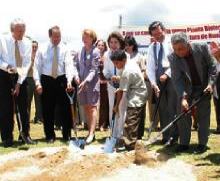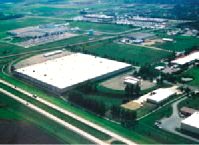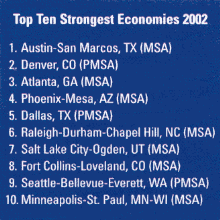|
Lilly Growing in Puerto Rico Too
 NOTHING COULD BE FINER: Eli Lilly executives join with local residents and community officials to break ground on a $450-million facility in Carolina, Puerto Rico. The plant is Lilly’s third major facility announcement of 2002, with total investment surpassing $1 billion.
|
|
In addition to major investments in its hometown of Indianapolis and in Prince William County, Virginia, Eli Lilly and Co. broke ground in July on another whopper: a $450-million facility in Carolina that will manufacture Humalog®, Lilly’s biotechnology product derived from recombinant DNA that is used in the treatment of diabetes.
It is merely the continuation of a longstanding presence on the island for the pharmaceutical giant, which built its first facility there in 1965. Lilly Puerto Rico currently employs approximately 1,100 workers at three plants in Carolina and Mayaguez and 220 in its sales and marketing offices in San Juan.
Since the initial announcement in April 2001, the company has acquired property, filed permits, completed conceptual design and begun hiring new employees. Along the way, the project was expanded to include a dedicated warehouse facility, a utility building, an administration building and an independent laboratory facility for the site ? increasing the total investment from $250 million to $450 million and raising the number of new employees from 300 to 450. New jobs to be created as a result of the new facility include positions for biochemists, microbiologists, protein scientists, manufacturing operations and administrative personnel. Hiring will continue over the next two years until the 300,000-sq.-ft. (27,870-sq.-m.) facility becomes fully operational by late 2004.
|
All Play Means New Work in South Dakota
Faced with the availability of a huge parcel of land and one of the largest buildings in the state, residential playground equipment manufacturer Rainbow Play Systems has announced it will accelerate its expansion plans in Brookings, South Dakota, a move that will bring 100 new jobs and a new product line to the university town in 2003.
“This company has huge growth potential,” said Gov. Bill Janklow in welcoming the good news. There will be plenty of room to do that, what with the 518,000 sq. ft. of warehouse space, 39 loading docks, and a rail spur made available by the departure of TruServe Corp., the Chicago-based wholesale hardware cooperative that vacated the premises last February as part of a streamlining effort. Rainbow will immediately start to phase out its Minnesota operation and consolidate its entire operation in Brookings, which will bring the company’s total employment to more than 300 … about equal to TruServe’s employment at its peak of operations.
“The impact over the long term is going to be huge,” says Richard L. (Dick) Smith, executive director of the Brookings Economic Development Corp. “Of course it helps preserve the tax base. Large boxes like that deteriorate quickly if left empty.
 A BROOKINGS INSTITUTION: Rainbow Play Systems is now moving its entire operation to South Dakota, aided in part by a $1.5-million low-interest loan from the state’s REDI Fund, which awards incentives based on job creation.
|
|
The company beat out several competing bidders in purchasing the facility, including another hardware distributor and a clothing distributor. A $1.5-million low-interest loan was made available through the state’s REDI Fund, which awards the incentives based on job creation. Rainbow has grown quickly since first locating about seven years ago in the hometown of South Dakota State University, about 50 miles north of Sioux City on Interstate 29, and just west of the Minnesota border. The initial plan — creating 75 jobs in a 35,000-sq.-ft. facility — was outgrown long ago, as the company already occupies more than 400,000 sq. ft today.
Other major employers in the area include 3M Corp., Larson Doors and electronic scoreboard system manufacturer Daktronics, which spun out of the university in the early 1960s and now employs 1,200. Rainbow has rapidly become part of the community’s corporate core.
“As the owner of that business has proclaimed,” says Smith of the more than doubling of space, “‘I have underestimated everything since the day I started in Brookings, and I don’t want to underestimate again.'”
|
Austin Tops Economic Strength
Rankings for Fourth Straight Year

The 8th annual study by Florida-based POLICOM Corp. of 318 U.S. metros found that Austin, Texas, retains its title as the nation’s strongest local economy. Edging out runner-up Denver and third-place Atlanta, Austin displayed the power of endurance that is the primary trait of the ranking study, which is based on performance over a 25-year span.
“This is not a ‘quality of life’ or ‘best places to live’ study,” says William H. Fruth, POLICOM president. “Nor does it try to identify the latest economic ‘hot spot.’ The study measures the economic soundness of an area. The perspective of the study is how the economy affects people who work and live in an area. If companies are looking for a location for long-term growth in a stable environment, go to one of the top 50 in my study and you’re going to find that.”
The study considers 18 factors based purely on data from the U.S. Bureau of Economic Analysis — among them earnings per capita and sector, employment and distress measures — and giving double emphasis on the metrics over the most recent decade. The most obvious trend? A diversified economic base in the thriving communities, and a one-trick pony base for those that are faltering. In addition, unlike most headline-grabbing locale studies, rapidity of growth is assessed in equal measure with growth over time. Raleigh, North Carolina, is the prototype, with about seven different economically contributing sectors. Over the eight years of the study, in addition to Austin’s consistent victories, Denver and Dallas have shown the steadiest growth.
Fruth, author of Where the Money Is: America’s Strongest Local Economies, is a sought-after expert on geographic economics. His credentials include four years as mayor of Tiffin, Ohio, and the honor of Florida Economic Development Professional of the Year in 1987. Over the past four years, he has worked with communities in 28 states to help them see where their true strengths and weaknesses are.
“If you’re rated high, it’s a great study, and if you’re rated low, it’s a bad study,” he quips in relating typical feedback from chambers of commerce and ED groups. “After they discover that this is not opinion, it is mathematics, there have been many, like Flint, Michigan, that say ‘Okay, we have a real problem, what can we do about solving this problem?'”
 William H. Fruth
|
|
Fruth observes that many areas in gradual decline don’t necessarily recognize it.
“I’ve gone into many areas where the trend lines have been straight downhill for some time and the community is just shocked,” he says, “and they say, ‘No wonder the young people are all moving away.'”
On the other side of the coin is a state like Texas, whose leaders made the conscious decision 25 years ago to diversify from oil and cattle, or a city like Green Bay, Wisconsin, which has made the Top 25 from the beginning.
“They don’t have the most rapid growth, but they’re like a rock,” says Fruth. “They’ve had some industries falter up there, but at the same time they’ve had others grow.”
The hot topic on Fruth’s agenda today is the impact of what he calls punitive growth management regulations, which artificially increase costs and threaten to slow growth.
“The old reason why economies declined was an unstable work force — that’s a kind term for militant union labor activity,” he says. “The modern-day reason is regulations, fees and taxes.”
|
ABB Breaks Ground for New Power Circuit Breaker Factory
ABB Inc., part of the Switzerland-based ABB Group, held groundbreaking ceremonies in August for a new high-voltage power circuit breaker facility in Greensburg, Penn., that will employ 250-300 people.
Expected to be operational in March 2003, the 130,000-sq.-ft. (12,077-sq.-m.) facility is located on approximately 20 acres in Westmoreland Distribution Park, not far from the company’s present plant, which employs around 200. That plant’s capabilities came to the fore last year in helping New York City restore its power systems after the Sept. 11 terrorist attacks.
The new project is being developed by Dallas-based McMahon Development Group, which will lease it back to ABB. Company officials pointed to their existing work force and supplier base as key factors in the decision to expand in Southwestern Pennsylvania, a process helped along by a $450,000 economic package that includes grant and job training funds.
The ABB Group of companies operates in more than 100 countries and employs about 150,000 people in the manufacture of technology products for power transmission and power distribution, including transformers, switchgear, breakers, capacitors and cables. The Swedish-Swiss corporation recently unloaded its entire portfolio in Sweden for approximately $300 million, with plans to lease back 75 percent of the 1.1 million sq. m. (11.8 million sq. ft.) of Swedish space as part of a global $1.5-billion debt reduction plan. Another part of that plan was accomplished in September, when ABB sold off its structured finance unit to General Electric’s Commercial Finance unit for $2.3 billion, amid talk that its petrochemicals division might be unloaded in a similar fashion.
|
Two Bridges, One Goal

Kentucky and Indiana leaders have come together on a plan to build two new bridges across the Ohio River, a $1.4-billion recommendation that now awaits federal approval.
“Two bridges have been part of the transportation plans for this region for many years,” said Indiana Gov. Frank O’Bannon. “We want them to be built as one project.”
“Gov. O’Bannon and I are united in this recommendation and confident that it is the right decision,” said Kentucky Gov. Paul Patton. So far, elected officials from both states have helped to secure $42 million in federal appropriations.
The recommendation came after several years of intensive study. Working with the project consultant, Community Transportation Solutions, agencies with the two states have maintained a Web site, hosted 300 community meetings and reviewed nearly 5,000 public comments. The final recommendation was deemed the best long-term solution for the region’s economy and its accompanying growth in both commuter and commercial traffic. It also holds promise for industrial development: for example, one new related interchange will provide access to planned development at the Indiana Army Ammunition Plant site and the nearby Clark Maritime Center.
If final approval by the Federal Highway Administration comes by year’s end as anticipated, design and right-of-way acquisition should take 2-3 years, with construction taking an estimated 10 years.
|
Going With the Wind:
Raytheon Moves On Down the Road
Leading defense, aerospace and electronics contractor Raytheon will build a new 150,000-sq.-ft. (13,935-sq.-m.) global headquarters in Waltham, Mass., with construction slated to be complete by the fourth quarter of 2003.
The company’s former headquarters, three miles away in Lexington, has been sold to a joint venture for an undisclosed amount, with proceeds going toward the new facility. The land for the headquarters, located in Waltham Woods Corporate Center, will be leased from the Massachusetts Medical Society, and Leggat McCall Properties will develop and build the facility.
“This move gets us a more modern, efficient and attractive facility at a lower cost of operation,” said Daniel P. Burnham, chairman and CEO of Raytheon.
After finishing ahead of schedule on a project that began in February 1999, Daimler-Chrysler Corp. recently opened a new US$37.5-million wind tunnel facility that will provide the company with state-of-the-art aerodynamic and acoustic testing capability in the design and engineering of future vehicles.
The 31,000-sq.-ft. (2,880-sq.-m.) Aero-Acoustic Wind Tunnel facility, which will also be used for racing vehicle development, can accommodate vehicles up to 10,000 pounds. The 18-foot turntable permits precise positioning of vehicles during testing. The facility’s fans can generate winds in excess of 150 miles per hour to assess aerodynamic drag and wind noise.
“The wind tunnel is the cornerstone of our lab and test facilities,” said Donald Goodwin, Vice President and head of the Scientific Laboratories and Proving Grounds for Chrysler Group. “Our proximity to the rest of the vehicle design and engineering functions will reduce the time and cost of bringing a new vehicle to market. For example, we can provide test results on new clay models to the Design Center on an overnight basis.”
A team of seven aerodynamic and acoustic engineers will conduct operations at the new facility, which is already fully booked through the end of 2002.
|

|



